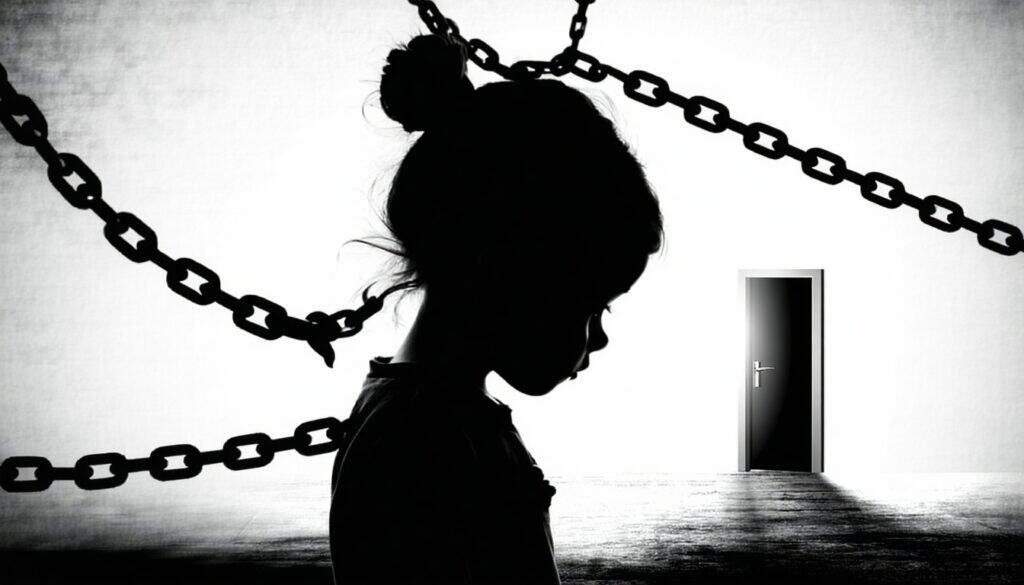What Is Child Trafficking? A Clear Definition for Iowans
When you picture child trafficking, do you imagine shadowy networks in distant countries? Think again. It’s happening in our own neighborhoods—in schools, homes, truck stops, and online spaces across Iowa. Often unnoticed. Often misidentified. But always devastating.
What Is Child Trafficking?

Child trafficking is happening in Iowa—often hidden in plain sight, but what is child trafficking?How is it defined.
It involves the exploitation of children for commercial sex or forced labor. Under U.S. and Iowa law, any commercial sex act involving a minor is trafficking, even without force or coercion. Labor trafficking includes forcing kids to work through threats, lies, or manipulation.
Common myths—like trafficking always involves kidnapping or movement—make it harder to recognize. In reality, traffickers are often people the child knows, and trafficking can occur within a single community.
Understanding the legal definitions, recognizing red flags, and debunking myths are key steps Iowans can take to protect vulnerable youth and support prevention and response efforts across the state.
Legal Definition of Human Trafficking
What is child trafficking? … according to the law? At its most basic level, child trafficking involves exploiting a child for compelled labor, services, or commercial sex acts. The Trafficking Victims Protection Act (TVPA), the key federal law in the U.S., provides a legal framework. Essentially, it defines human trafficking through specific actions, means, and purposes:
- Action: Recruiting, harboring, transporting, providing, obtaining, patronizing, or soliciting a person.
- Means: Using force, fraud, or coercion.
- Purpose: For involuntary servitude, debt bondage, slavery, or commercial sex acts.
Crucially, for children under 18 involved in commercial sex acts, the “Means” element (force, fraud, or coercion) does not need to be proven. The law recognizes that children cannot legally consent to commercial sex. Their involvement is trafficking, regardless of whether they appear to agree or were forced.
What is Child Trafficking? According to Federal and Iowa Law

Understanding the legal definitions is vital for holding traffickers accountable and ensuring victims receive the protections they deserve.
- Federal Definition (TVPA):
- Sex Trafficking: Inducing a person under 18 to perform a commercial sex act, OR using force, fraud, or coercion to induce a person of any age to perform such an act.
- Labor Trafficking: Using force, fraud, or coercion to recruit, harbor, transport, provide, or obtain a person for labor or services in involuntary servitude, peonage, debt bondage, or slavery.
- Iowa Definition (Iowa Code Chapter 710A):
- Iowa law aligns closely with federal definitions but specifies certain actions within the state. Under Iowa Code § 710A.2, human trafficking includes recruiting, luring, enticing, harboring, transporting, providing, or obtaining a person through force, fraud, or coercion for forced labor, servitude, or commercial sexual activity.
Significantly, Iowa law also explicitly defines human trafficking as “knowingly purchasing or attempting to purchase services involving commercial sexual activity from a victim or another person engaged in human trafficking” legis.iowa.gov.
This highlights the demand side of sex trafficking. The code also defines “involuntary servitude” as a condition induced by schemes or threats causing a person to believe they or someone else would suffer serious harm, physical restraint, or abuse of the legal process if they didn’t comply legis.iowa.gov
(Disclaimer: This provides a general overview. For specific legal advice or the most current interpretations, consult legal professionals or official state resources. Legal information can change and is subject to case law and regulations childwelfare.gov, law.justia.com).
Types of Child Trafficking In Iowa
When asking what is child trafficking? It generally falls into two main categories:
- Child Sex Trafficking: This involves the exploitation of a child (under 18) through commercial sexual activity. Traffickers might use grooming techniques, manipulation, false promises of love or a better life, threats against the child or their family, or substances to control the victim. As noted, legally, a child cannot consent to commercial sex.
- Learn more about the specific nature of this threat in Iowa:
[Link to Child Sex Trafficking in Iowa page]
- Learn more about the specific nature of this threat in Iowa:
- Child Labor Trafficking: This involves compelling a child to work or provide services through force, fraud, or coercion. This can occur in various settings, including domestic servitude (like forced nannying or housekeeping), agriculture, factories, restaurants, construction, or illicit activities. Victims may face long hours, little or no pay, dangerous conditions, and isolation.

Common Myths About Child Trafficking In Iowa
Misunderstandings can prevent us from recognizing and responding to trafficking. Here are some common myths:
- Myth: Trafficking requires movement across state or national borders.
- Reality: Trafficking frequently happens within a single town, city, or county. Victims may be trafficked in their own homes or communities. Movement is not required for it to be trafficking.
- Myth: Victims always try to escape or ask for help.
- Reality: Victims are often controlled through intense fear, manipulation, threats against loved ones, trauma bonding, or dependence on the trafficker. They may not feel safe or able to seek help.
- Myth: Traffickers are always strangers or violent criminals.
- Reality: Traffickers can be anyone, including family members, romantic partners, friends, employers, or seemingly legitimate figures recognizeandreport.org
- . They often build trust or exploit existing relationships.
- Myth: Child trafficking doesn’t happen in places like Iowa.
- Reality: Child trafficking occurs in urban, suburban, and rural communities across the United States, including Iowa. No community is immune. Vulnerabilities exist everywhere.
Definitions Matter for Iowa

Having a clear, accurate child trafficking definition is the first step towards meaningful action in Iowa. It helps:
- Community Members: Recognize potential red flags and know when a situation requires reporting.
- Law Enforcement & Prosecutors: Properly identify and charge traffickers under Iowa law.
- Service Providers: Understand the specific needs and rights of child survivors.
- Educators & Parents: Implement effective prevention strategies.
- All Iowans: Understand the severity of the issue and advocate for stronger protections.
Conclusion –
Child trafficking is a complex crime rooted in exploitation and control. Understanding the precise definition – especially the critical distinction that force, fraud, or coercion are not required elements for sex trafficking involving a minor – is crucial for everyone in Iowa. By grasping the reality of what child trafficking entails under both federal and state law, differentiating between types, and dispelling harmful myths, we can become more effective allies in the fight to protect Iowa’s children.
Want to learn more about the overall picture of child trafficking in our state and how you can make a difference? Visit our comprehensive guide:
[Link to Pillar Post: Child Trafficking in Iowa: Your Complete Guide to Awareness, Prevention, and Taking Action]




